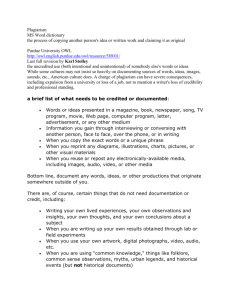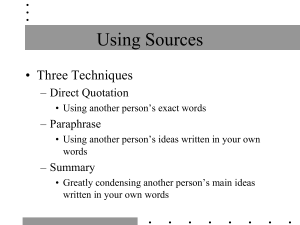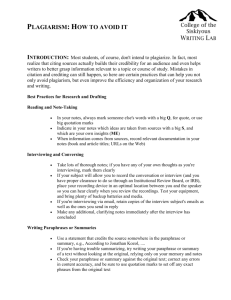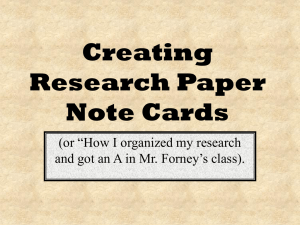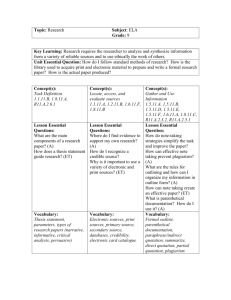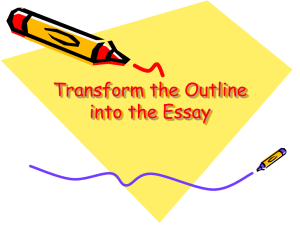Tips and Examples for Writing Thesis Statements
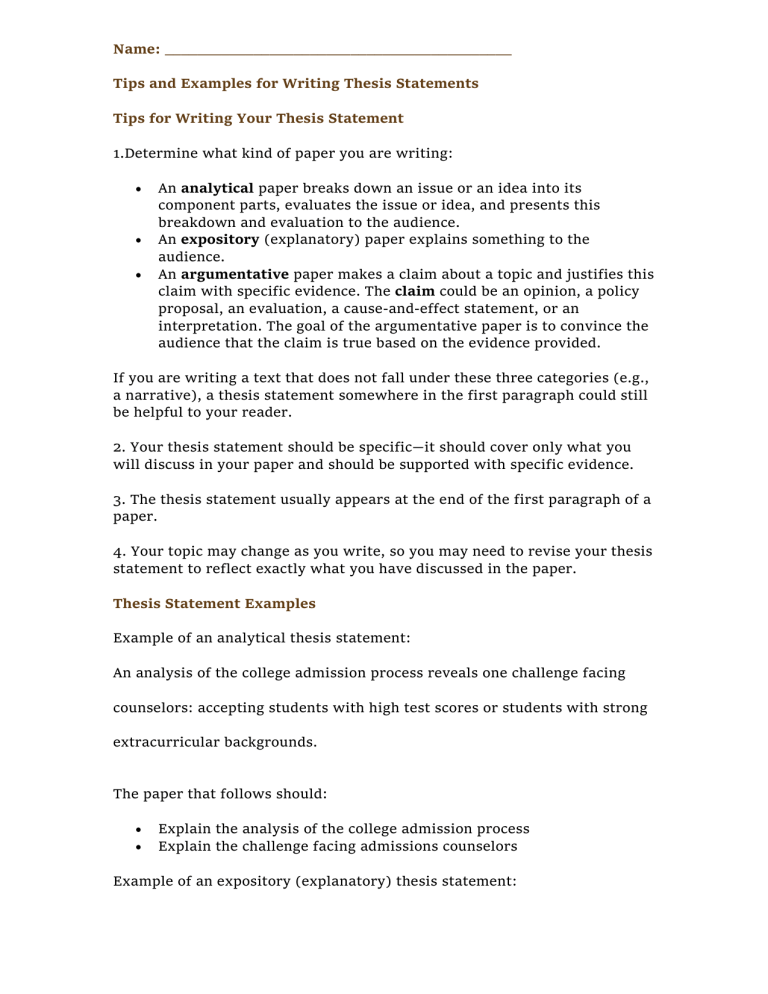
Name: ___________________________________________
Tips and Examples for Writing Thesis Statements
Tips for Writing Your Thesis Statement
1.Determine what kind of paper you are writing:
An analytical paper breaks down an issue or an idea into its component parts, evaluates the issue or idea, and presents this breakdown and evaluation to the audience.
An expository (explanatory) paper explains something to the audience.
An argumentative paper makes a claim about a topic and justifies this claim with specific evidence. The claim could be an opinion, a policy proposal, an evaluation, a cause-and-effect statement, or an interpretation. The goal of the argumentative paper is to convince the audience that the claim is true based on the evidence provided.
If you are writing a text that does not fall under these three categories (e.g., a narrative), a thesis statement somewhere in the first paragraph could still be helpful to your reader.
2. Your thesis statement should be specific—it should cover only what you will discuss in your paper and should be supported with specific evidence.
3. The thesis statement usually appears at the end of the first paragraph of a paper.
4. Your topic may change as you write, so you may need to revise your thesis statement to reflect exactly what you have discussed in the paper.
Thesis Statement Examples
Example of an analytical thesis statement:
An analysis of the college admission process reveals one challenge facing counselors: accepting students with high test scores or students with strong extracurricular backgrounds.
The paper that follows should:
Explain the analysis of the college admission process
Explain the challenge facing admissions counselors
Example of an expository (explanatory) thesis statement:
The life of the typical college student is characterized by time spent studying, attending class, and socializing with peers.
The paper that follows should:
Explain how students spend their time studying, attending class, and socializing with peers
Example of an argumentative thesis statement:
High school graduates should be required to take a year off to pursue community service projects before entering college in order to increase their maturity and global awareness.
The paper that follows should:
Present an argument and give evidence to support the claim that students should pursue community projects before entering college
Paraphrase: Write It in Your Own Words
Paraphrasing is one way to use a text in your own writing without directly quoting source material. Anytime you are taking information from a source that is not your own, you need to specify where you got that information.
A paraphrase is...
Your own rendition of essential information and ideas expressed by someone else, presented in a new form.
One legitimate way (when accompanied by accurate documentation)
to borrow from a source.
A more detailed restatement than a summary, which focuses concisely on a single main idea.
Paraphrasing is a valuable skill because...
It is better than quoting information from an undistinguished passage.
It helps you control the temptation to quote too much.
The mental process required for successful paraphrasing helps you to grasp the full meaning of the original.
6 Steps to Effective Paraphrasing
1.
Reread the original passage until you understand its full meaning.
2.
Set the original aside, and write your paraphrase on a note card.
3.
Jot down a few words below your paraphrase to remind you later how you envision using this material. At the top of the note card, write a key word or phrase to indicate the subject of your paraphrase.
4.
Check your rendition with the original to make sure that your version accurately expresses all the essential information in a new form.
5.
Use quotation marks to identify any unique term or phraseology you have borrowed exactly from the source.
6.
Record the source (including the page) on your note card so that you can credit it easily if you decide to incorporate the material into your paper.
Some examples to compare
The original passage:
Students frequently overuse direct quotation in taking notes, and as a result they overuse quotations in the final [research] paper. Probably only about
10% of your final manuscript should appear as directly quoted matter.
Therefore, you should strive to limit the amount of exact transcribing of source materials while taking notes. Lester, James D. Writing Research
Papers. 2nd ed. (1976): 46-47.
A legitimate paraphrase:
In research papers students often quote excessively, failing to keep quoted material down to a desirable level. Since the problem usually originates during note taking, it is essential to minimize the material recorded verbatim (Lester 46-47).
An acceptable summary:
Students should take just a few notes in direct quotation from sources to help minimize the amount of quoted material in a research paper (Lester 46-
47).
A plagiarized version:
Students often use too many direct quotations when they take notes, resulting in too many of them in the final research paper. In fact, probably only about 10% of the final copy should consist of directly quoted material.
So it is important to limit the amount of source material copied while taking notes.
A note about plagiarism: This example has been classed as plagiarism, in part, because of its failure to deploy any citation. Plagiarism is a serious offense in the academic world. However, we acknowledge that plagiarism is a difficult term to define; that its definition may be contextually sensitive; and that not all instances of plagiarism are created equal—that is, there are varying “degrees of egregiousness” for different cases of plagiarism.
Paraphrasing Exercise
Directions: On a separate piece of paper, write a paraphrase of each of the following passages. Try not to look back at the original passage.
1. "The Antarctic is the vast source of cold on our planet, just as the sun is the source of our heat, and it exerts tremendous control on our climate,"
[Jacques] Cousteau told the camera. "The cold ocean water around
Antarctica flows north to mix with warmer water from the tropics, and its upwellings help to cool both the surface water and our atmosphere. Yet the fragility of this regulating system is now threatened by human activity."
From "Captain Cousteau," Audubon (May 1990):17.
2. The twenties were the years when drinking was against the law, and the law was a bad joke because everyone knew of a local bar where liquor could be had. They were the years when organized crime ruled the cities, and the police seemed powerless to do anything against it. Classical music was forgotten while jazz spread throughout the land, and men like Bix
Beiderbecke, Louis Armstrong, and Count Basie became the heroes of the young. The flapper was born in the twenties, and with her bobbed hair and short skirts, she symbolized, perhaps more than anyone or anything else,
America's break with the past. From Kathleen Yancey, English 102
Supplemental Guide (1989): 25.
3. Of the more than 1000 bicycling deaths each year, three-fourths are caused by head injuries. Half of those killed are school-age children. One study concluded that wearing a bike helmet can reduce the risk of head injury by 85 percent. In an accident, a bike helmet absorbs the shock and cushions the head. From "Bike Helmets: Unused Lifesavers," Consumer
Reports (May 1990): 348.
4. Matisse is the best painter ever at putting the viewer at the scene. He's the most realistic of all modern artists, if you admit the feel of the breeze as necessary to a landscape and the smell of oranges as essential to a still life.
"The Casbah Gate" depicts the well-known gateway Bab el Aassa, which pierces the southern wall of the city near the sultan's palace. With scrubby coats of ivory, aqua, blue, and rose delicately fenced by the liveliest gray outline in art history, Matisse gets the essence of a Tangier afternoon, including the subtle presence of the bowaab, the sentry who sits and surveys those who pass through the gate. From Peter Plagens, "Bright Lights."
Newsweek (26 March 1990): 50.
5. While the Sears Tower is arguably the greatest achievement in skyscraper engineering so far, it's unlikely that architects and engineers have abandoned the quest for the world's tallest building. The question is: Just how high can a building go? Structural engineer William LeMessurier has designed a skyscraper nearly one-half mile high, twice as tall as the Sears
Tower. And architect Robert Sobel claims that existing technology could produce a 500-story building. From Ron Bachman, "Reaching for the Sky."
Dial (May 1990): 15.
Safe Practices
Most students, of course, don't intend to plagiarize. In fact, most realize that citing sources actually builds their credibility for an audience and even helps writers to better grasp information relevant to a topic or course of study.
Mistakes in citation and crediting can still happen, so here are certain
practices that can help you not only avoid plagiarism, but even improve the efficiency and organization of your research and writing.
Best Practices for Research and Drafting
Reading and note-taking
In your notes, always mark someone else's words with a big Q, for quote, or use big quotation marks
Indicate in your notes which ideas are taken from sources with a big S, and which are your own insights (ME)
When information comes from sources, record relevant documentation in your notes (book and article titles; URLs on the
Web)
Interviewing and conversing
Take lots of thorough notes; if you have any of your own thoughts as you're interviewing, mark them clearly
If your subject will allow you to record the conversation or interview
(and you have proper clearance to do so through an Institutional
Review Board, or IRB), place your recording device in an optimal location between you and the speaker so you can hear clearly when you review the recordings. Test your equipment, and bring plenty of backup batteries and media.
If you're interviewing via email, retain copies of the interview subject's emails as well as the ones you send in reply
Make any additional, clarifying notes immediately after the interview has concluded
Writing paraphrases or summaries
Use a statement that credits the source somewhere in the paraphrase or summary, e.g., According to Jonathan Kozol, ...).
If you're having trouble summarizing, try writing your paraphrase or summary of a text without looking at the original, relying only on your memory and notes
Check your paraphrase or summary against the original text; correct any errors in content accuracy, and be sure to use quotation marks to set off any exact phrases from the original text
Check your paraphrase or summary against sentence and paragraph
structure, as copying those is also considered plagiarism.
Put quotation marks around any unique words or phrases that you cannot or do not want to change: e.g., "savage inequalities" exist throughout our educational system (Kozol).
Writing direct quotations
Keep the source author's name in the same sentence as the quote
Mark the quote with quotation marks, or set it off from your text in its own block, per the style guide your paper follows
Quote no more material than is necessary; if a short phrase from a source will suffice, don't quote an entire paragraph
To shorten quotes by removing extra information, use ellipsis points
(...) to indicate omitted text, keeping in mind that: o In longer quotes where you have omitted a sentence in between o other complete sentences, maintain terminal puncutation in between the ellipses.
Example: "None of the national reports I saw made even passing references to inequality or segregation. . . . Booker T.
Washington was cited with increasing frequency, Du Bois never, and Martin Luther King only with cautious selectivity." (Kozol
3).
To give context to a quote or otherwise add wording to it, place added words in brackets, ( [] ); be careful not to editorialize or make any additions that skew the original meaning of the quote—do that in your main text, e.g., o OK: Kozol claims there are "savage inequalities" in our educational system, which is obvious. o WRONG: Kozol claims there are "[obvious] savage inequalities" in our educational system.
Use quotes that will have the most rhetorical, argumentative impact in your paper; too many direct quotes from sources may weaken your credibility, as though you have nothing to say yourself, and will certainly interfere with your style
Writing about another's ideas
Note the name of the idea's originator in the sentence or throughout a paragraph about the idea
Use parenthetical citations, footnotes, or endnotes to refer readers to additional sources about the idea, as necessary
Be sure to use quotation marks around key phrases or words that the idea's originator used to describe the idea
Maintaining drafts of your paper
Sometimes innocent, hard-working students are accused of plagiarism because a dishonest student steals their work. This can happen in all kinds of ways, from a roommate copying files off of your computer, to someone finding files on a disk or on a pen drive left in a computer lab. Here are some practices to keep your own intellectual property safe:
Do not save your paper in the same file over and over again; use a numbering system and the Save As... function; E.g., you might have research_paper001.doc, research_paper002.doc, research_paper003.doc as you progress. Do the same thing for any
HTML files you're writing for the Web. Having multiple draft versions may help prove that the work is yours (assuming you are being ethical in how you cite ideas in your work!).
Maintain copies of your drafts in numerous media, and different secure locations when possible; don't just rely on your hard drive, pen drive, or the cloud.
Password-protect your computer; if you have to leave a computer lab for a quick bathroom break, hold down the Windows key and L to lock your computer without logging out.
Password-protect your files; this is possible in all sorts of programs, from Adobe Acrobat to Microsoft word (just be sure not to forget the password!).
Revising, proofreading, and finalizing your paper
Proofread and cross-check with your notes and sources to make sure that anything coming from an outside source is acknowledged in some combination of the following ways: o In-text citation, otherwise known as parenthetical citation o Footnotes or endnotes o o o o
Bibliography, References, or Works Cited pages
Quotation marks around short quotes; longer quotes set off by themselves, as prescribed by a research and citation style guide
Indirect quotations: citing a source that cites another source
If you have any questions about citation, ask your instructor well in advance of your paper's due date, so if you have to make any adjustments to your citations, you have the time to do them well
Works Cited
Kozol, Jonathan. Savage Inequalities: Children in America's Schools.New
York: Crown Publishers, Inc., 1992. Print.
Films or Movies
List films (in theaters or not yet on DVD or video) by their title. Include the name of the director, the film studio or distributor, and the release year. If relevant, list performer names after the director’s name. Use the abbreviation perf. to head the list. List film as the medium of publication. To cite a DVD or other video recording, see “Recorded Films and Movies” below.
The Usual Suspects. Dir. Bryan Singer. Perf. Kevin Spacey, Gabriel Byrne, Chazz
Palminteri, Stephen Baldwin, and Benecio del Toro. Polygram, 1995. Film.
To emphasize specific performers (perf.) or directors (dir.), begin the citation with the name of the desired performer or director, followed by the appropriate abbreviation.
Lucas, George, dir. Star Wars Episode IV: A New Hope. Twentieth Century Fox,
1977. Film.
Recorded Films or Movies
List films by their title. Include the name of the director, the distributor, and the release year. If relevant, list performer names after the director’s name.
Use the abbreviation perf. to head the list. End the entry with the appropriate medium of publication (e.g. DVD, VHS, Laser disc).
Ed Wood. Dir. Tim Burton. Perf. Johnny Depp, Martin Landau, Sarah Jessica
Parker, Patricia Arquette. Touchstone, 1994. DVD.
Broadcast Television or Radio Program
Begin with the title of the episode in quotation marks. Provide the name of the series or program in italics. Also include the network name, call letters of the station followed by the city, and the date of broadcast. End with the publication medium (e.g. Television, Radio). For television episodes on
Videocassette or DVD refer to the “Recorded Television Episodes” section below.
"The Blessing Way." The X-Files. Fox. WXIA, Atlanta. 19 Jul. 1998. Television.
Recorded Television Episodes (e.g. DVD, Videocassette)
Cite recorded television episodes like films (see above). Begin with the episode name in quotation marks. Follow with the series name in italics.
When the title of the collection of recordings is different than the original series (e.g., the show Friends is in DVD release under the title Friends: The
Complete Sixth Season), list the title that would be help researchers locate the recording. Give the distributor name followed by the date of distribution.
End with the medium of publication (e.g. DVD, Videocassette, Laser disc).
Note: The writer may choose to include information about directors, writers, performers, producers between the title and the distributor name. Use appropriate abbreviations for these contributors (e.g. dir., writ., perf.,
prod.).
"The One Where Chandler Can't Cry." Friends: The Complete Sixth Season. Writ.
Andrew Reich and Ted Cohen. Dir. Kevin Bright. Warner Brothers, 2004.
DVD.

